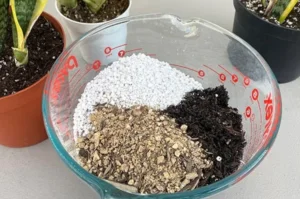Snake plants, known as Sansevieria or mother-in-law’s tongue, are popular indoor plants for their hardiness and air-purifying abilities. They thrive in low-light conditions, need minimal water, and are known to survive a bit of neglect. However, one common question among snake plant owners is: Do snake plants need fertilizer?
The short answer is yes, but in moderation. While snake plants can survive without fertilizer for a long time, the right feeding routine can help them grow faster, maintain vibrant leaves, and stay healthy.
In this article, we’ll explore why snake plants need fertilizer, how often to fertilize them, what type of fertilizer to use, and common mistakes to avoid.
Do Snake Plants Need Fertilizer?
Snake plants are low-maintenance and adapt well to different environments, which often makes people assume they don’t need fertilizer at all. While it’s true that these plants can survive with minimal care, giving them the right nutrients will improve their growth and overall appearance.
Fertilizer provides essential nutrients like nitrogen (N), phosphorus (P), and potassium (K) that support healthy roots, strong leaves, and better resistance to pests and diseases.
Without fertilizer, snake plants may:
- Grow very slowly
- Have dull or yellowing leaves
- Develop weaker roots over time
Benefits of Fertilizing Snake Plants
Here are some advantages of using fertilizer for your snake plant:
1. Faster Growth
Fertilizer gives the plant the extra energy it needs to push out new leaves and expand its root system.
2. Brighter, Healthier Leaves
Proper nutrients make the leaves look greener, shinier, and more vibrant.
3. Stronger Resistance to Disease
A well-fed plant can better defend itself against root rot, pests, and fungal infections.
4. More Frequent Propagation
When snake plants grow well, they produce more offshoots or pups, which you can use to grow new plants.
What Type of Fertilizer is Best for Snake Plants?
Choosing the right fertilizer is essential. Snake plants don’t like heavy feeding, so a balanced, diluted fertilizer is the best option.
1. Balanced Liquid Fertilizer (10-10-10 or 20-20-20)
A balanced fertilizer contains equal parts of nitrogen, phosphorus, and potassium. This type supports even growth and is easy to apply during watering.
2. Succulent or Cactus Fertilizer
Snake plants belong to the succulent family, so fertilizers made for succulents are also ideal. They are gentle and low in nitrogen, which reduces the risk of overfeeding.
3. Slow-Release Fertilizer
This type of fertilizer slowly releases nutrients over time, providing long-term nourishment without frequent application.
Important Tip: Always dilute liquid fertilizer to half or quarter strength. Snake plants are sensitive, and too much fertilizer can burn their roots.
How Often Should You Fertilize a Snake Plant?
Fertilizing too often can do more harm than good. Snake plants only need fertilizer during their growing season, which is typically spring and summer.
Here’s a simple fertilizing schedule:
| Season | Fertilizer Frequency |
| Spring | Once every 4–6 weeks |
| Summer | Once every 4–6 weeks |
| Fall | Stop or feed once lightly |
| Winter | No fertilizer needed |
During winter, snake plants go dormant and don’t grow much. Feeding them during this time can lead to salt buildup in the soil, which may damage the roots.
Signs Your Snake Plant Needs Fertilizer
Here are some signs that indicate your snake plant might benefit from a feeding:
- Very slow or no growth during spring and summer
- Pale or yellow leaves
- Weak or drooping leaves
- Lack of new shoots or pups
Keep in mind that these symptoms can also be caused by poor lighting, overwatering, or root issues, so it’s important to rule those out first.
Common Mistakes to Avoid When Fertilizing
Even though snake plants don’t require much fertilizer, improper use can cause serious damage. Avoid these common mistakes:
1. Over-Fertilizing
Too much fertilizer can lead to fertilizer burn, causing brown leaf tips or root damage. Always follow the recommended dosage and dilute the solution.
2. Fertilizing in Winter
Plants rest during colder months and won’t use the nutrients, which can lead to toxic buildup in the soil.
3. Using the Wrong Fertilizer
Fertilizers high in nitrogen (meant for leafy vegetables or lawns) can overwhelm snake plants. Use a balanced or succulent-friendly product.
4. Fertilizing a Stressed Plant
Don’t feed your plant if it’s recently been repotted, suffering from pests, or recovering from overwatering. Let it heal before applying fertilizer.
Natural Alternatives to Chemical Fertilizers
If you prefer an organic approach, here are some natural fertilizers safe for snake plants:
1. Compost Tea
A light solution made from compost steeped in water can offer a mild nutrient boost.
2. Worm Castings
These are rich in nutrients and safe to mix into the potting soil or sprinkle on top.
3. Banana Peel Water
Soak banana peels in water for a day or two and use the water for your plant. It’s rich in potassium and safe in small amounts.
Conclusion
So, do snake plants need fertilizer? Yes — but only a little, and only during their active growing months. While snake plants can survive without feeding, a gentle fertilizer routine helps them grow better, look healthier, and resist diseases.
Use a diluted, balanced liquid or succulent fertilizer once a month during spring and summer. Avoid feeding in winter, and always be cautious not to over-fertilize. With the right care, your snake plant will reward you with strong, beautiful foliage year-round.






